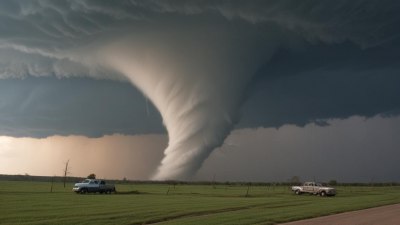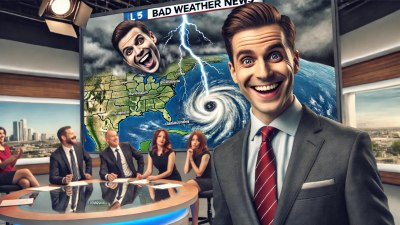The Hidden Meteorology of Public Mood Swings
Explore the unseen forces shaping public mood swings, from media influence to sociopolitical dynamics in a detailed analysis.

Understanding the fluctuations in public mood is akin to studying the complex mechanisms of meteorology. Just as weather patterns are affected by an intricate web of atmospheric conditions, public moods shift due to multiple, interwoven factors. This article delves into the hidden meteorology of public mood swings, unpacking the subtle drivers behind collective emotional changes and their implications across society.
The Conceptual Framework of Public Mood
Public mood can be defined as the prevailing emotional atmosphere shared by a large group of people over a given period. Unlike individual emotions, which are personal and transient, public mood represents collective feelings shaped by social, economic, political, and media influences. These moods often manifest in social behaviors, including voting patterns, consumer confidence, and public sentiment toward policies or events.
Just like weather, public moods are not static; they fluctuate based on stimuli. The metaphor of meteorology is fitting; humanity’s mass psyche responds dynamically to external pressures and internal feedback loops, similar to air pressure changes or humidity shifts signaling a storm.
Media as the Atmospheric Pressure of Public Emotions
Media outlets act like atmospheric pressure systems, either stabilizing or destabilizing public mood. News media, social platforms, and entertainment sources provide the information that can trigger moods of hope, fear, anxiety, or euphoria. The 24-hour news cycle amplifies this effect, as continuous coverage can intensify emotions or create mood storms.
Social media algorithms further modulate public emotional states by selectively exposing individuals to content that resonates with existing beliefs or amplifies emotional responses. This selective exposure can lead to echo chambers and reinforce polarization, resulting in more volatile public moods similar to turbulent weather in localized atmospheres.
Economic Indicators and Mood Climates
Economic conditions significantly influence the public’s collective mood. High unemployment rates, inflation, or market instability often correlate with pervasive anxiety, pessimism, and social unrest. Conversely, periods of economic growth and prosperity tend to foster optimism, confidence, and willingness to engage positively with society.
Economic shocks can be conceptualized as cold or warm fronts moving into the public’s emotional climate, abruptly shifting attitudes. For example, the 2008 global financial crisis triggered widespread feelings of distrust and fear, comparable to a prolonged winter storm across many societies.
Political Events as Fronts and Cyclones
Politics serves as a powerful force shaping public moods. Elections, policy changes, and geopolitical events can function like cold fronts, rapidly cooling the public’s enthusiasm, or like warm fronts, raising collective spirits through hope and confidence. Political polarization often generates cyclone-like effects, creating intense emotional energy concentrated in opposition camps, resulting in frequent and severe mood swings.
Public reaction to political leadership embodies this metaphor. Charismatic leaders can act as high-pressure systems, uplifting public morale and stabilizing national mood. Conversely, scandals or failures may be low-pressure systems that introduce uncertainty and instability.
Social Movements: Emotional Hurricanes
Social movements, whether grassroots protests or mass advocacy campaigns, can function as emotional hurricanes. They channel collective anger, hope, or frustration into focused energy capable of reshaping societal conditions. The mood swings generated here are intense and rapid, with the potential to alter the emotional landscape permanently.
For instance, movements advocating for civil rights or climate action often begin with growing social tensions that reach a breaking point, causing a surge of emotional intensity. This surge can catalyze social change but also provoke counter-movements that contribute to mood volatility within society.
Climate and Seasonal Affects on Public Psychology
Beyond metaphorical meteorology, actual climate and seasons demonstrably influence public mood. Seasonal Affective Disorder (SAD) is a clinical example of how reduced sunlight during winter can cause depression in many individuals, a phenomenon that scales to larger populations affecting overall mood climate.
Weather events such as storms, heatwaves, or cloudy days can impact mood states by influencing physiological factors like vitamin D levels, serotonin production, and outdoor activity. Consequently, national or regional public mood swings can in part be traced back to the physical environment, making biological and environmental meteorology fundamental to understanding collective emotional dynamics.
Psychological Feedback Loops as Atmospheric Circulation
Feedback loops in psychology serve as atmospheric circulation patterns, distributing emotional energy across different segments of society. Positive feedback loops, where optimistic news generates more confidence, which in turn promotes positive actions and further optimism, resemble high-pressure systems stabilizing weather.
Conversely, negative feedback loops follow the pattern of low-pressure systems that intensify storms. For example, fear spreading through social media can increase anxiety, which causes more fearful content consumption, reinforcing the emotional downturn.
Technological Amplification of Emotional Weather
Modern technology not only disseminates information but also accelerates the speed and intensity of public mood changes. Instant communication means emotional storms can form rapidly and spread globally within minutes. Viral content, trending hashtags, and online communities act like jet streams, steering emotional currents and influencing distant demographic clusters in synchronized mood shifts.
This technological amplification can reduce the natural damping of emotional fluctuations, leading to more intense peaks and troughs in public mood, akin to extreme weather events becoming more frequent and severe.
Case Study: The COVID-19 Pandemic and Global Mood Patterns
The COVID-19 pandemic provides a comprehensive illustration of public mood swings influenced by multiple meteorological-like forces. Early optimism about controlling the virus gave way to fear and anxiety as case numbers rose and uncertainty increased. Lockdowns and new information caused mood shifts resembling successive atmospheric fronts sweeping across populations.
Information dissemination via social and traditional media created pressure systems shaping public response. Economic impacts triggered widespread pessimism, while scientific breakthroughs and vaccination campaigns produced hopeful warm fronts. The pandemic highlighted the interconnectedness and complexity of forces behind collective moods.
Implications for Policy and Leadership
Recognizing the meteorological nature of public moods offers valuable insights for policymakers and leaders. Just as meteorologists predict weather to prepare communities, understanding public mood fluctuations can guide effective communication strategies, crisis management, and social interventions.
Leaders must monitor the emotional atmospheric conditions, crafting messages that stabilize rather than exacerbate mood swings. Transparency, empathy, and timely information serve as tools to manage public emotions, preventing destructive storm surges of panic or apathy.
Applying Mood Meteorology in Marketing and Business
Businesses can leverage the principles of mood meteorology to optimize consumer engagement strategies. By tracking economic indicators, media trends, and societal sentiment, companies can time product launches or campaigns to coincide with positive public moods, maximizing impact.
Conversely, sensitivity to negative public climates can help brands avoid missteps during periods of collective pessimism or unrest. Understanding these cycles mirrors the way savvy farmers adapt planting schedules to forecasted weather, aligning business activities with emotional climates for better outcomes.
The Future of Public Mood Prediction
Emerging fields like sentiment analysis, big data analytics, and artificial intelligence are advancing the capacity to predict public mood swings with greater accuracy. Combining social media monitoring, economic data, and psychological insights creates detailed models akin to sophisticated meteorological simulations.
These developments promise to enhance governance, marketing, and social planning by anticipating emotional shifts and mitigating harmful effects. However, ethical considerations about privacy and manipulation must guide the use of such technologies.
Ultimately, public moods are the invisible weather of societies, shaping actions and decisions at every level. By understanding this hidden meteorology, we gain tools to navigate the emotional currents that define human collective experience.











